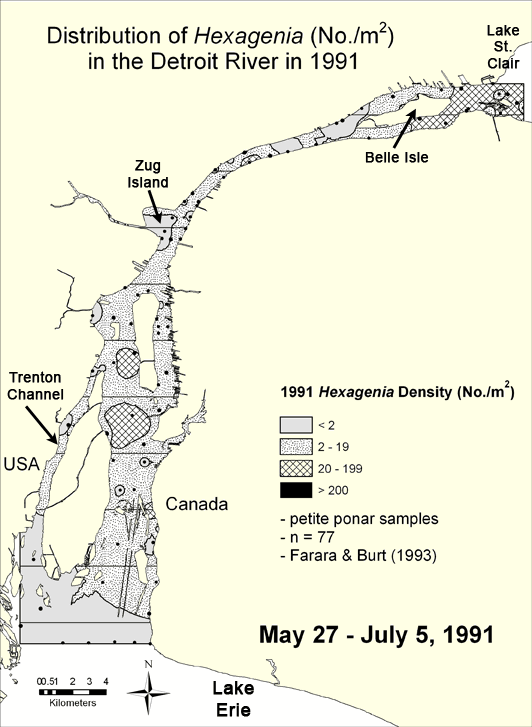Detroit River-Western Lake Erie Basin Indicator Project
Hexagenia Density and Distribution in the Detroit River
Larval Distribution, 1991
Pollution controls put in place during the 1970s resulted in improved water and sediment quality in many areas. When the river was surveyed again in 1980, mayflies were found at over 70% of the locations examined, and they were 5 times more abundant than in 1968 (Thornley 1985; ). Densities exceeded 20 per square meter in both the upper and lower reaches of the Detroit River, being absent mainly south of Zug Island and in the Trenton Channel.
Few changes in either the distribution or abundance of mayfly nymphs were seen between the 1980 survey, a 1983 investigation (Hudson et al. 1986), and a study done in 1991 (Farara and Burt 1993). In 1991, Hexagenia mayflies were found at about 60% of locations sampled, at densities of between 8 and 100 nymphs per square meter (Figure 4). However, more of the river supported densities slightly less than the 20 per square meter criterion suggested to indicate impairment (Ciborowski 2003b) than had been observed in 1980. Worms and midges remained the most common invertebrates along the United States shoreline of the river downstream from Zug Island.
Little benthic sampling was conducted in the Detroit River through most of the 1990s, so information on health of the zoobenthic community during this time is scarce. However, the flying adult stages of Hexagenia and other aquatic insects became more numerous along both the Canadian and United States sides of the river and along the shores of Lake Erie (Ciborowski and Corkum 1988; Kovats 1990; Kovats et al. 1996; Corkum et al. 1997) suggesting that some improvements in river condition had been occurring.

Figure 4. Density of Hexagenia in the Detroit River in 1991 interpolated from data compiled from Farara and Burt (1993). Areas containing fewer than 20 nymphs per square meter indicate either degraded benthic conditions (if sediments are soft) or unsuitable habitat for mayflies (if sediments are hard). Map by Anita Kirkpatrick.
Go to full text of Hexagenia Density and Distribution in the Detroit River
Go to the next map, Distribution of Hexagenia in 1999